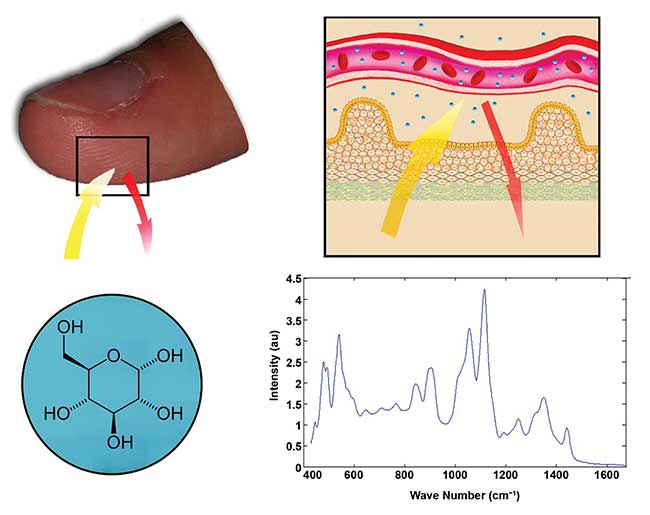Researchers have long pursued a noninvasive way to measure blood glucose. With spectroscopy a significant contender, we asked three experts about the advantages it presents and the obstacles it faces.
 For more than 30 years, scientists have sought a reliable noninvasive method to monitor blood sugar — for good reason. Invasive testing requires taking blood samples, either through blood draws at the lab or, for known diabetics, testing at home through frequent fingertip lancing. Over the years, the lancing devices have become smaller and the meters and test strips that analyze blood samples at home easier to use. But the fact remains: Testing for blood sugar is painful and inconvenient.
Nor can these invasive methods, which give point-in-time measurements, yield the continuous monitoring that can best serve diabetics. Such monitoring would enable individuals to manage their blood sugar throughout the day and bolster their efforts to forestall complications that include stroke and heart disease and kidney damage.
Some 422 million people worldwide have diabetes, according to 2014 statistics from the World Health Organization. That’s nearly four times the number of people who had the disease in 1980. So it’s little wonder that noninvasive glucose monitoring has been called the Holy Grail of biomedical research.
Spectroscopy checks off all the right boxes for the technology behind a noninvasive monitor. Spectroscopic probes are pain-free and typically do not harm the body. The technology is reliable. And it can lend itself to the kind of miniaturization required for a wearable device appropriate for home use and capable of making continuous measurements.
But the prize remains elusive. To get a clearer picture of the reasons why this is so — and why spectroscopy particularly holds so much promise — we reached out to three experts in field who are Ishan Barman, Igor K. Lednev and John Maynard.
For more than 30 years, scientists have sought a reliable noninvasive method to monitor blood sugar — for good reason. Invasive testing requires taking blood samples, either through blood draws at the lab or, for known diabetics, testing at home through frequent fingertip lancing. Over the years, the lancing devices have become smaller and the meters and test strips that analyze blood samples at home easier to use. But the fact remains: Testing for blood sugar is painful and inconvenient.
Nor can these invasive methods, which give point-in-time measurements, yield the continuous monitoring that can best serve diabetics. Such monitoring would enable individuals to manage their blood sugar throughout the day and bolster their efforts to forestall complications that include stroke and heart disease and kidney damage.
Some 422 million people worldwide have diabetes, according to 2014 statistics from the World Health Organization. That’s nearly four times the number of people who had the disease in 1980. So it’s little wonder that noninvasive glucose monitoring has been called the Holy Grail of biomedical research.
Spectroscopy checks off all the right boxes for the technology behind a noninvasive monitor. Spectroscopic probes are pain-free and typically do not harm the body. The technology is reliable. And it can lend itself to the kind of miniaturization required for a wearable device appropriate for home use and capable of making continuous measurements.
But the prize remains elusive. To get a clearer picture of the reasons why this is so — and why spectroscopy particularly holds so much promise — we reached out to three experts in field who are Ishan Barman, Igor K. Lednev and John Maynard.
Member Exclusive: To read the complete article, please Login or Register